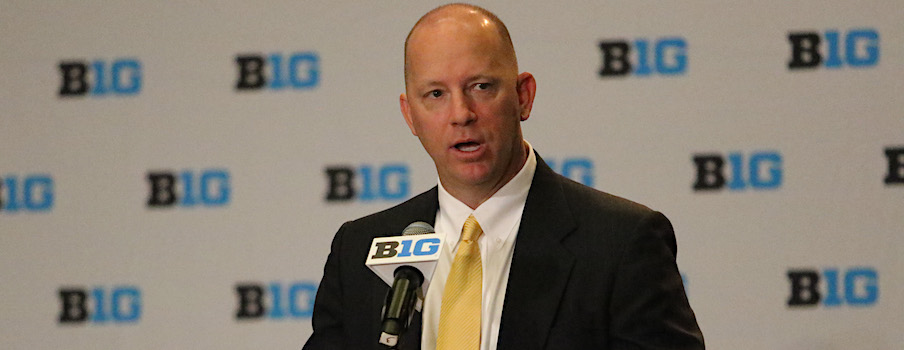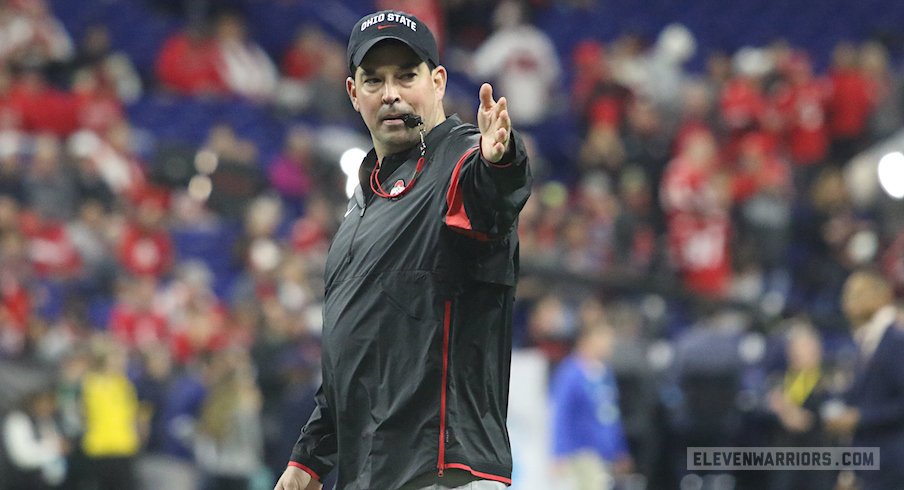Now that the Big Ten has ruled out the possibility of playing fall football, the conference and its football coaches have turned their attention toward coming up with a plan that will allow them to play this winter or spring.
Over the course of this week, two potential models for a postponed Big Ten football season have already emerged. Ohio State coach Ryan Day is among those advocating for a season that would begin in the first week of January and conclude in March. Another model proposed by Purdue coach Jeff Brohm calls for the season to start in late February and end in May.
Both models come with a bevy of questions, as there are many skeptics who are opposed to the notion of a spring football season altogether. It’s an option that has to be explored, though, now that it’s the only option left on the table for Big Ten football teams to play a season during the 2020-21 academic year.
Given that, we take a look at both models below and weigh the pros and cons of each, as well as the arguments for why it would or would not be better to simply skip ahead to the fall of 2021 now that the Big Ten has decided against playing in the fall of 2020.
Option 1: The Day Model (Winter Football)
Since Day told reporters on Wednesday that he was pushing for an eight-game season that would start in the first week of January, that has seemingly emerged as the most likely model for second-semester Big Ten football.
Sports Illustrated’s Albert Breer reported Thursday that the proposed regular season would start on Jan. 1 and run through the final weekend of February, while the Big Ten Championship Game would be played the first weekend of March. Depending on whether the ACC, Big 12 or SEC end up also postponing their seasons, the conference championship game could be followed by a College Football Playoff or a Rose Bowl between the Big Ten and Pac-12 champs.
Per Breer, the Big Ten’s plan would be to play in indoor stadiums within the conference’s regional footprint; Detroit, Indianapolis, Minneapolis, St. Louis and Syracuse are all potential options. Yahoo Sports’ Pete Thamel reported that Day’s proposal also calls for teams holding preseason camps in December. Breer also reported that the NFL is willing to accommodate this plan by moving back its scouting combine and draft, which would allow 2021 draft prospects to participate in the spring season if they so choose.
Pros
- Unless the conference changes course on its current stance, which is highly unlikely at this point, this would be the earliest possible opportunity for Big Ten teams to return to game action.
- By ending the season in March, this model would still allow for the possibility of a full 2021 fall season to be played as scheduled – with about five-and-a-half months between seasons – while also giving upperclassmen the opportunity to participate in the season and potentially improve their NFL draft stocks.
- Assuming the league’s TV partners are on board with this model, it would enable the Big Ten to make up for at least some of the revenue it will lose this fall.
Cons
- The idea of playing two seasons in one calendar year is a non-starter for some, and this model would set Big Ten teams up to play at least 20 games – and as many as 25 games for a national championship contender like Ohio State – in just 12 months if a full fall season is played in 2021.
- Given that the Big Ten was unable to get to a point where it felt comfortable playing fall football over the last five months, there’s reason to be skeptical that another five months will be enough for the conference to prepare for an unprecedented winter season. The COVID-19 pandemic isn’t likely to be eradicated by the start of 2021, so will it really be safer for teams to play football on Jan. 1 than it would have been on Sept. 1? Even if the Big Ten commits to this model, there’s still a significant chance the games will never actually happen.
- If the season is played in neutral-site domes – which is the only reasonable option considering the typical January-February weather in Big Ten country – they’ll also likely be played without fans, so this model won’t help schools make up for the ticket revenue they’re losing this fall, nor will it help local businesses who profit from home games.
Option 2: The Brohm Model (Spring Football)
Brohm’s proposal, which he put together on his own and shared with the public in a seven-page outline on Thursday, calls for an eight-game regular season that would begin on Feb. 27 and conclude on April 17, while the postseason – which could either consist of a Big Ten Championship Game followed by a Rose Bowl and/or 4-team CFP, or a 6-team CFP – would be held between May 1-15.
In turn, the fall 2021 season would be shortened to 10 regular-season games and start in October. Brohm’s plan also calls for padded practices to be limited for the next two seasons and for no spring practices to be held in 2022 to reduce the wear and tear on players’ bodies between the 2021 and 2022 seasons.
— Purdue Football (@BoilerFootball) August 13, 2020
— Purdue Football (@BoilerFootball) August 13, 2020
Pros
- By playing in the actual spring rather than winter, this model would allow for games to be played at teams’ home stadiums and potentially enable teams to host fans, opening up the possibility that this season could be played in a traditional gameday atmosphere and for schools and local businesses to generate home game revenue.
- Waiting two additional months to play increases the likelihood that a COVID-19 vaccine would be developed in time for the season and would give the Big Ten more time to develop its health and safety protocols for the postponed season.
- Plan accounts for increased toll on players’ bodies and impact on future seasons, which will be necessary for any spring football model.
Cons
- This model guarantees that Big Ten teams would not play a full 12-game schedule until 2022 and would force teams to cancel or reschedule non-conference games to fit the new 2021 schedule. Is playing in the spring really worth it if it also means being unable to play a traditional season next fall?
- While it’s still possible the NFL could partially accommodate this model – the collective bargaining agreement allows for the draft to be pushed back as far as June 2 – it’s increasingly less likely that 2021 draft hopefuls would play in a season that ends in April or May.
- Even with a shortened fall season that starts later, this plan would still give teams less time between seasons than Day’s preferred model, while it would still call for teams to play at least 18 games in less than 10 months, while a team could potentially play as many as 24 games in less than 11 months.

Option 3: No 2020-21 Season
While the Big Ten’s goal as of now is to make a winter/spring season happen – and that season could end up looking different than either of the models above, or potentially become a blend between them – there are many doubters (understandably so) who believe the conference’s decision to postpone the season will ultimately result in no season at all.
For any season to happen during the 2020-21 academic year, the Big Ten will likely have to get to a point where it’s comfortable staging football games while the COVID-19 pandemic remains a part of American life, and more time doesn’t guarantee that will happen. If the past week was any indication, it’s also far from a given that the conference will be able to get everyone on the same page to agree on a winter/spring season model.
All of that makes it very possible that the fall of 2021 will be the next time we’ll actually see Big Ten teams play football games.
Pros
- Any spring football model has the potential to adversely affect the 2021 fall season due to the decreased turnaround time between seasons. It might make more sense to focus on next season rather than trying to salvage this season, especially if COVID-19 cases don’t significantly decrease nationwide by the end of 2020.
- The winter/spring season has the potential to be a watered-down product if top players sit out, and any champion crowned will come with an asterisk because of the unusual circumstances. It might not be worth the trouble.
- The player safety concerns of 18-25 games in one calendar year are real, and even players who aren’t 2021 NFL draft prospects might have to make tough decisions on whether they should play two seasons in one year.
Cons
- The obvious: We’d have to wait another full year to see Big Ten football again. Conference teams would have a 20-21 month layoff between their final game of 2019 and their first game of 2021.
- Schools would lose a full year of football game revenue, forcing athletic departments to make even bigger budget cuts than they’ll likely already have to make this fall.
- If there’s no 2020-21 season and all players receive an additional year of eligibility, scholarship limits will likely have to be adjusted and rosters could become backlogged, which could hurt recruiting for future classes.
What’s the Best Option?
There’s really no clear-cut answer to that question. There’s no perfect alternative to playing the fall season as scheduled, which means the Big Ten’s next move will be suboptimal one way or another.
Playing any football in the next 12 months would be preferable to playing no football at all, but the consequences that a spring season could have on the subsequent fall season and on the players themselves also need to be considered in the conference’s decision-making.
The answer to this question could also depend in part on whether the ACC, Big 12 and SEC are able to play their fall seasons or if they also punt to the second semester, though there’s still pros and cons to consider in both scenarios.
On one hand, those conferences playing in the fall could increase the incentive for the Big Ten to play in the spring, as not doing so could put Big Ten schools at a significant recruiting disadvantage; on the other hand, it would give the Big Ten less to play for if a national champion has already been crowned, while less turnaround time between seasons could also put the Big Ten at a disadvantage for the fall of 2021.
Big Ten football programs will be hoping the other Power 5 conferences ultimately follow their conference’s lead, which could lead to everyone playing on the same winter/spring timeframe and put them back on an equitable playing field with a chance to compete for a national title. Yet that could also increase the likelihood that no one plays college football until next fall.
There’s no ideal option left now, but the Big Ten owes it to its football programs and players to weigh all of the pros and cons as it determines what its next move should be.


